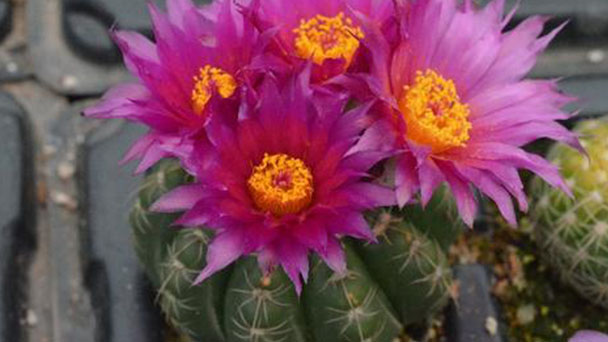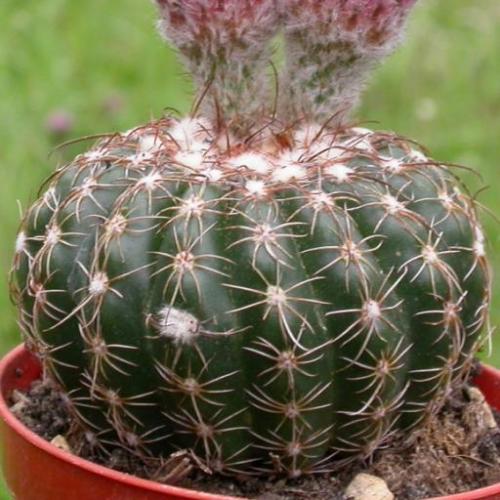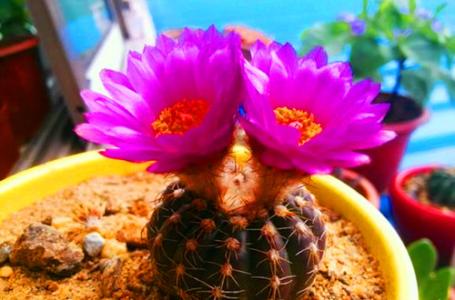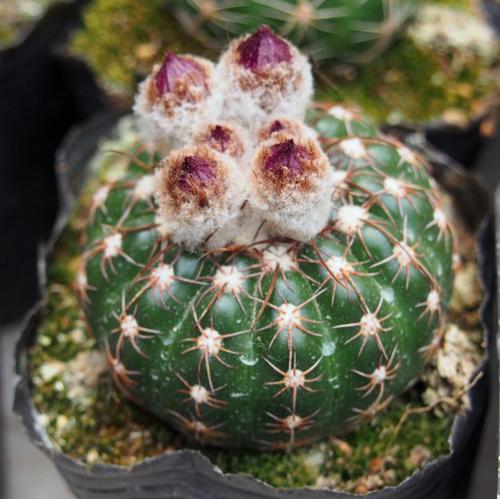Parodia werneri pofile
Written by Maggie
Mar 09 2021

Parodia Werneri is a succulent plant of the genus Parodia in the family Cactus. Parodia werneri is native to Rio de Janeiro, Brazil, and grows in rocky areas between the plains. Parodia werneri are usually solitary plants, sometimes with small spheres at the base of the plant.
Parodia werneri picture

The distribution of Parodia werneri
Parodia Werneri is a native of the Central and South Brazilian Plateau.
Morphological characteristics of Parodia werneri
Parodia werneri is a solitary plant, spherical to elliptic, 6-8 cm in diameter, 10-12 cm in height, dark green in color. Shallow ribs with 13-15 round verrucate.8-10 radiate preferential spines; parodia werneri has no thorn; The new thorns are yellow-brown, the old ones are grayish-brown.
Flowers: Maximal purple bell-shaped flowers in spring and summer, 3-3.5 cm in diameter, flowering from June to July.
The ecological habits of Parodia werneri
Parodia werneri likes to grow in a sunny environment, but it should be shaded properly in the high temperature and heat season in summer, and higher air humidity is needed in the growing period.
Parodia Werneri likes warm, dry and sunny environments. parodia Werneri is resistant to drought and semi-shade. It is not resistant to moisture. Growth temperature is 18°C - 24°C, not cold resistance, winter temperature is not less than 5°C, short term can withstand low temperature of 0°C. It is advisable to use fertile, loose, well-drained sandy loam and a mixture of leaf rot soil, culture soil and coarse sand.
Parodia Werneri is easy to plant, strong and fast to grow. Roots developed, potted every spring to change pots, pruning roots. Growing period basin soil to keep wet, appropriate amount of fertilizer.Keeping the soil dry in winter increases its resistance to cold.
How to grow and care for Parodia werneri
In order to keep its plant body clean and beautiful, Parodia Werneri is best to cultivate in the greenhouse, glass case or with transparent plastic film bags to cover the plant. Adapts to well-permeable sandy loam rich in humus. Keep the basin soil slightly dry in winter and can withstand the low temperature of 3°C.
Parodia werneri are mostly non-breedable pellets, which are usually grafted by cutting the top to promote the growth of the pellets, and then taking off the pellets for grafting propagation.

How to propagate Parodia werneri
Parodia werneri is commonly used for sowing and cutting, grafting propagation.
Sowing
Because Parodia werneri has many flowers and is easy to bear fruit, the collected seeds can be sown in the same year, and the emergence rate is high. The growth of the seedlings is not slow. If the seedlings are grafted early, the growth is fast and the flowers can be seen earlier.
Sowing of Parodia Werneri was carried out in spring, and the suitable temperature for germination was 20°C to 24°C. After sowing, the seedlings sprouted 1 to 2 weeks later, and the diameter of the seedlings could reach more than 1cm in the next year. Cuttage: in spring and autumn is appropriate, the mother plant beside the ball cut off, dry the wound after inserted in the sand bed, after 25-30 days can take root.
Grafting
Parodia werneri are mostly non-breedable pellets, which are usually grafted by cutting the top to promote the growth of the pellets, and then taking off the pellets for grafting propagation.
In spring, the stock can be used in the days, Parodia Werneri, biennial seedling scion or the mother plant next to the ball. After the next 15 days or so can heal alive, after the rapid growth.
Disease Control of Parodia werneri
Parodia Werneri Rare pests and diseases. Sometimes root rot, anthrax, red spider and other hazards, can be symptomatic prevention.
Parodia werneri main value
Parodia werneri is a single plant, spherical to oval, can be made for small pot ornamental.

Latest Updated
- Benefits of Bugleweed - 7 Science-backed Health Benefits
- Bugleweed Dangers & Side Effects - Is It Poisonous?
- How to Plant Evergreen Trees - What You Should Know
- When to Plant Evergreens - Grow Guide for Evergreen Trees
- 12 Wonderful Evergreen Shrubs for Your Garden
- 12 Popular Evergreen Plants with Pictures for Beginners
- When And How To Prune A Lilac Bush Like a Pro
- How to Grow & Care for Lilac Vine (Hardenbergia Violacea)
- Japanese Lilac Tree (Syringa Reticulata) Care & Propagation Guide
- Shumard Oak Pros and Cons - What to Know
Popular Articles
- Winter maintenance of Antirrhinum Majus
- How to Grow Terminalia Mantaly Tree
- How to Grow and Care for Crossostephium Chinense
- How to grow Antirrhinum Majus in spring
- Peristeria Elata (Dove Orchid) Profile: Info & Care Guide
- Underwatered Snake Plant (Sansevieria Trifasciata) - Signs And How To Fix
- How to Care for Brazilian Jasmine Plant (Mandevilla Sanderi)
- How to Grow & Care for Graptopetalum Purple Delight in Summer
- Rosa Chinensis (China Rose): Plant Growing & Care Tips
- How to Care for Baby Sun Rose (Aptenia Cordifolia)